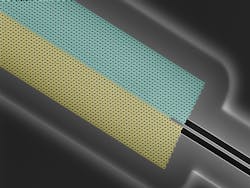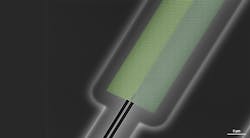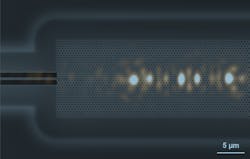Photonic topological insulators show no protection against backscattering
Integrated photonics can be fabricated today to contain only very minute defects, a.k.a. surface roughness, but it’s still impossible to eliminate them entirely—and this disorder can result in a loss of photons. Photonic quantum technologies require encoding information into fragile quantum states, so it’s essential to minimize these losses to enable quantum photonics to scale.
A team of Technical University of Denmark (DTU; Kongens Lyngby, Denmark) researchers decided to take a closer look at photonic topological interfaces (waveguides) designed to guide light through a chip to reduce this loss of photons/backscattering. Previous studies indicated it may be possible to prevent backscattering, but actual measurements of the losses and backscattering in topological waveguides had never been done.
“Simply put, we felt this was a key experiment missing within the field of topological photonics,” says Søren Stobbe, an associate professor in the department of electrical and photonics engineering at DTU.
Many researchers are currently delving into photonic topological insulators. “By now, it’s well established that photonic topological insulators can be fashioned into waveguides and cavities, with several experimentally tested designs for doing so—even recent ones that exhibit slow light,” Stobbe says. “From an application perspective, though, the main allure of these devices is the theoretical suggestion of protection against backscattering, especially within the regime of slow light.”
The potential to completely eliminate backscattering in slow light waveguides can’t be overstated: beyond enabling the engineering of more efficient and compact devices for telecommunications and sensing, it would open the door to a wide range of devices in quantum photonics.
“Many types of materials and geometries have been suggested, but only the ‘valley-Hall’ waveguides were real contenders for low-loss backscattering-protected waveguides,” says Stobbe. “Experiments are very important here because modeling the effects of real-world disorder is numerically intractable, so the input from theory is important but not sufficient. But to our surprise, nobody had ever measured the losses in valley-Hall waveguides—so we decided to do the experiment.”
Exploring losses in valley-Hall photonic topological waveguides
Valley-Hall photonic topological waveguides are based on a topological variant: the valley-Chern number. “This means putting two mirrored crystals together is guaranteed to result in a guided mode along their interface,” explains Christian Anker Rosiek, a Ph.D. student working with Stobbe. “These types of designs are quite recent, with the first valley-Hall waveguide experimentally demonstrated in 2019, and the first experiment showing slow light in these waveguides in 2021, so the field is very young and many questions remain unanswered.”
To create their structures, the team used a state-of-the-art silicon photonic membrane technology (see Fig. 1). “This is important because no topological insulator would protect against arbitrary levels of disorder, so we needed to study the lowest levels of disorder achievable,” Rosiek says.
They validated this by studying conventional photonic-crystal waveguides fabricated on the same chips as the topological waveguides, so the statistics of the disorder were the same for the two sets of waveguides.
“The measured losses in the conventional waveguides were in fact a record low, and the question was then if the topological waveguides would be able to suppress the backscattering arising from these record-low levels of structural defects,” says Rosiek. “As it turns out, this is not the case.”
The team’s main takeaway is that protection against backscattering doesn’t seem to work for time-reversal symmetric systems.
“For fundamental reasons, we can’t rule out from an experiment that they would work at even lower levels of structural disorder—but we would be surprised if that’s the case,” says Guillermo Arregui, a postdoc working with Stobbe. “Another important takeaway from our experiment is the fact that light is guided around sharp bends in topological waveguides, which has been a common test until now, says absolutely nothing about the protection against backscattering on real-world disorder.”
Observing individual localized modes
It was a big moment for the team to observe individual localized modes for the first time (see Fig. 2).
“Since Anderson localization is a statistical phenomenon, we have to look at many disorder realizations, or many waveguides, to characterize the disorder and make conclusions for the platform in general,” says Rosiek.
But somehow, “just looking at the statistical aggregates makes it difficult to appreciate what happens at the level of the individual waveguide,” Rosiek adds. “So seeing these intricate patterns of light scattered from the high-Q localized modes, appearing and disappearing randomly for each waveguide as the wavelength is swept, made the whole concept much more tangible, which was really cool.”
Magneto-optic materials
So far, the team sees no compelling arguments that protection against backscattering can exist without breaking time reversal symmetry. “To eliminate backscattering, it’s likely researchers will need to use magneto-optic materials,” says Arregui. “This is also how the first photonic topological insulators were implemented within the microwave domain. Time modulation might be another possible way.”
This is a big challenge for the optical domain, because existing materials have an extremely weak magneto-optical response.
And metamaterials, quasicrystals, and 2D materials suffer from the same problems as photonic crystals, because “it isn’t really possible to break time-reversal symmetry with existing materials without introducing losses,” Arregui explains.
Multiple domains of photonic topological insulators
The field of photonic topological insulators can be divided into multiple domains, including low-loss waveguides based on conventional materials, active devices such as lasers for out-of-plane emission, studies of exotic states of light, and the search for low-loss magneto-optic materials at optical frequencies.
“As far as the first domain, I’m not very optimistic and hope our work can help guide the community toward more realistic goals as well as experiments that address the most important questions,” says Stobbe.
For the other domains, “there is plenty to be explored—the field is in its infancy,” he adds.
The team is now exploring a new class of materials, which so far haven’t been considered in the context of photonic topological insulators, “but it’s too early yet to say if we can succeed in creating low-loss optical materials that break time-reversal symmetry, which is the most important goal for the field right now,” Stobbe says.
FURTHER READING
C. A. Rosiek et al., Nat. Photon. (2023); doi:10.1038.s41566-023-01189-x.
About the Author
Sally Cole Johnson
Editor in Chief
Sally Cole Johnson, Laser Focus World’s editor in chief, is a science and technology journalist who specializes in physics and semiconductors.



